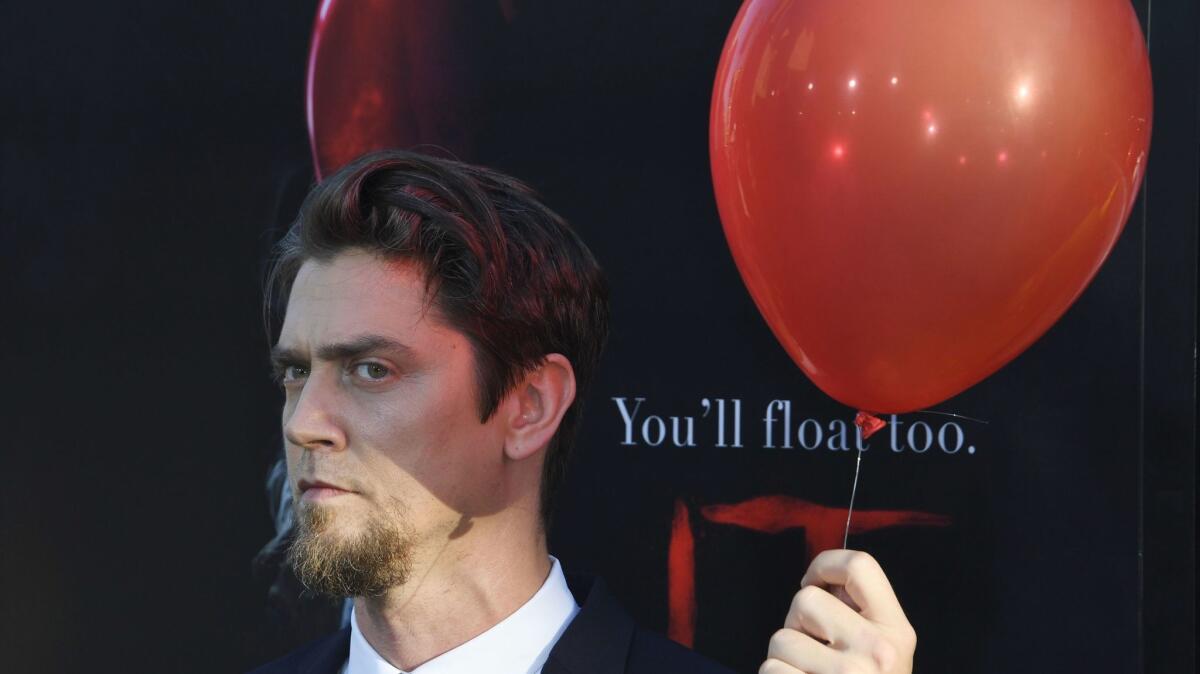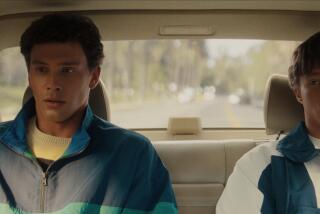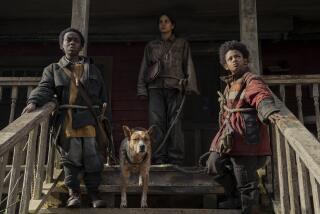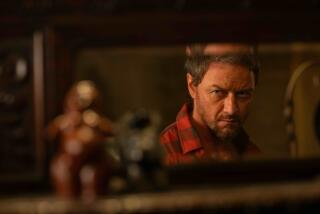With ‘It,’ Hollywood looks for hope in a classic of fear
Reporting from TORONTO — Film director Andy Muschietti stood on a soundstage and swiveled his head around the subterranean world he’d created.
The boyish-faced Argentine was attempting to bring “It,” the epically scaled Stephen King novel, to cinematic life.
Behind Muschietti, a winding set of constructed sewer tunnels criss-crossed like an Escher painting. A half-dozen child actors rehearsed looks of gasping horror. High above loomed a tower of creepdom — a multi-story mound studded with protruding shopping carts, bicycles and used clothing to form the world’s most macabre Christmas tree.
“I think we may need to do this a little bigger,” Muschietti said.

Bill Skarsgård plays a monster that takes the shape of a clown called Pennywise in the movie remake of “It,” based on the Stephen King novel.
He was referring, presumably, to the emotional feel of the scene. The director didn’t need to supersize much else about the project, which centers on the self-anointed “Losers Club” of early adolescents terrorized by demonic clown Pennywise. Everything about “It” is big — some in ways not desired or intended.
The 1986 novel not only clocks in at more than 1,100 pages but holds a special spot in the hearts of millions of teens, proving long ahead of “Harry Potter” and “The Hunger Games” that kids will devour literature if given the right genre fable. Even before Muschietti and his sister/producing partner Barbara came aboard, “It” had become the stuff of development-hell legend. “True Detective” auteur Cary Fukunaga spent six years working on the project before leaving in a creative clash with the studio.
Once the Muschiettis got to set last summer, things mushroomed further. The production design, under the hand of veteran Claude Pare, had begun to take on the feel of its own city. A modest $30-million budget for the New Line production started to grow, though by how much depends on whom you ask. The shooting schedule ballooned, going from a planned 52 days to nearly 80.
Now, as the R-rated film prepares to hit theaters Friday with Bill Skarsgard as Pennywise and “St. Vincent” standout Jaeden Lieberher as lead loser Bill Denbrough, it somehow looms even larger. A trailer did to the Internet what “Firestarter’s” Charlie McGee does to bullets. Tracking suggests a strong opening north of $55 million — a respite from a deadly drop of 16% at the box office this summer.
We signed up to make a good movie. We didn’t sign up to be box office saviors.
— Producer Seth Grahame-Smith

“It,” in other words, is saddled with the hope that the film can not only redeem its own tortuous history, can not only counteract the recent forgetability of the movie adaptation of King’s “The Dark Tower,” but can resuscitate the commercial fortunes of Hollywood itself.
“We signed up to make a good movie,” said Seth Grahame-Smith, the noted genre author who is also one of the film’s producers, in a recent phone interview. “We didn’t sign up to be box office saviors.” Still, you could hear the nervous anticipation in his voice.
“This is not by any means a normal horror movie,” added Grahame-Smith producing partner David Katzenberg by way of expectation-management.
It’s complicated material
To be sure, “It” is difficult source material. Set in disparate time periods nearly three decades apart (the 1950s of King’s childhood and the 1980s of the book’s publication), the story spans a massive amount of events and characters. Good kids, bad kids, good kids who may be possessed kids, parents of all insensitive stripes. The Losers’ fears — Pennywise essentially is a malleable manifestation of them all — requires a whiteboard to keep straight. (They include a mummy, leper, werewolf, drowning victims, bathroom blood and the ghost of a dead sibling.)
The book’s tone also veers heavily, from a tender coming-of-age story to a fearsome horror tale filled with acts of sexual abuse, neglect and imprisonment. And that’s just what the parents are doing.
The Muschiettis have somehow taken those polarities and doubled down on them. Pennywise is still chilling and the kids face torment from adult and bully alike. Yet the movie is a quippy, even jokey, affair — the brutality of an indie drama with the wry self-awareness of a modern teen comedy. (Unlike an ABC miniseries in 1990, the movie focuses only on the novel’s half that has to do with the Losers as children, updating it from the 1950s of King’s childhood to the 1980s. A present-day sequel with the kids as adults is tentatively in the works.)
“The size of the challenge is obviously considerable,” Andy Muschietti, 44, said. “If someone would come and tell you that there will be child abuse and silly humor together in the same movie you would think it was very strange.
“I don’t know what people make of those elements,” he added of a film whose commercial prospects rest in large part on viewers accepting this synthesis. “But I like to think I combined them in an instinctive way.”
Eight years ago the Muschiettis were in a very different place. They had made “Mama,” a horror short about two girls afraid of their mother. The Spanish-language ditty was a modest affair, taking place mainly in one room and costing barely $25,000, which they paid for themselves. Their parents did the catering.
Yet it was enough to attract the attention of famed director Guillermo del Toro, who came on as a producer, and Universal, which hired them for a feature adaptation. And that film in turn caught the attention of New Line. Seeking vision at an affordable price after the Fukunaga chapter, executives at the Warner Bros. division brought on the Muschiettis -- ensuring that a couple of below-the-radar South Americans would be stewarding this very American property.
“As children we were fascinated by fear, and the stories from the U.S. about fear,” Barbara Muschietti said of some early American influences as she took a break in her office across the stage’s parking lot. Barbara, 45, is the pragmatic half of the sibling pairing with her vision-y and goateed younger brother, the hard-charging yin to his dreamer yang.
“We really read a lot of Stephen King and Edgar Allan Poe and saw American movies. I think the interest in the genre started with ‘Close Encounters.’ We saw it as a horror movie. The fact that you as a little kid could be taken to a universe you didn’t know — that was frightening.” She also noted a number of South American authors as formative.
Barbara said it was this mix of sensibilities that helped her and her brother juggle so many tones. And when it didn’t, there was always a more old-school trick. “Andy goes a little crazy with the storyboards,” she said.
Tonal blends could also prove tough for others on set.
“It’s hard as an actor to find the balance between being strong and being afraid,” Lieberher, a casting director’s recent go-to for sensitive young souls, said during a break in shooting. Nearby Finn Wolfhard, a fellow “Loser” junior high-schooler who also stars in the 1980s chiller “Stranger Things,” mused that “it was very intense — these are kids but they’re kids who can be screaming.” He paused. “I really need to tell my agent to get me a rom-com.”
The actors went back to another scene. In this one Skarsgard was lying on the floor. He shook out his hands, exaggeratedly rotated his neck, flapped out one arm, then the other, an evil vision coming to life after sitting cooped up in a makeup trailer for hours. The final cut would find in his movements a compelling image, a clown that seemed to shape-shift in front of both characters and viewers.
Indeed, the cultural question at the heart of “It” is whether visual stylists like the Muschiettis can do what they did with “Mama” (and in a sense what King did with the book): craft artfully specific images that tap into a universal set of fears.
“It’s fascinating to watch a psychopath. We’re living in fear, and there are very capable forces, like presidential candidates, that feed off this,” Barbara said of the turbulent 2016 campaign. “Pennywise is able to represent things that are more evident now than ever.”
Andy offered a more general read.
“You have to go to what the essence of what Pennywise is about — the dark power of adulthood,” he said. “It’s not coincidence all the grown-ups in town are evil. This is not a story about a monster. It’s a story about the end of childhood.”
See the most-read stories in Entertainment this hour »
Twitter: @ZeitchikLAT
ALSO:
2017 fall movie preview: ‘It,’ ‘Battle of the Sexes,’ ‘Thor: Ragnarok’ and more
‘It’s’ new Pennywise actor Bill Skarsgard breaks down what makes the clown so scary
Review: ‘It’ delivers nightmarish visuals but misses the true horror of Stephen King’s classic
More to Read
Only good movies
Get the Indie Focus newsletter, Mark Olsen's weekly guide to the world of cinema.
You may occasionally receive promotional content from the Los Angeles Times.











